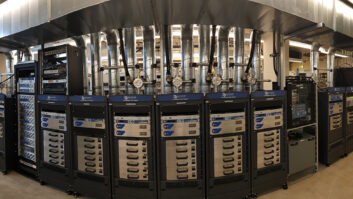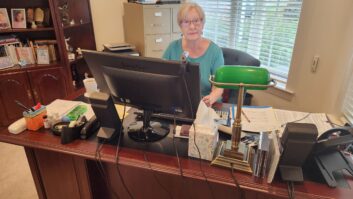Applied Technology: SDR in the Broadcast Environment
Nov 1, 2014 9:00 AM, By Brandon Malatest, Per Vices
The software-defined radio (SDR) is redefining the way we look at information transmission and retrieval. SDR technology is capable of covering a huge part of the spectrum and displaying the information in a digital format. The world of RF communication has changed. SDR technology is affordable, high quality, versatile and available today.
The tools of SDR are simple: an RF front end, a method of converting the raw data into a digital format, and software to manipulate the digitized data. In the case of SDR in broadcast environments, the incoming RF signal is down converted to a lower frequency, typically the audio frequency band, determined by the input signal and the desired output. Once down converted, the signal is digitized and cleaned using digital signal processing (DSP). Using fairly simple software you can pick out one set of frequencies and process the information to decode audio, show a waterfall display or display text from an encoded signal.
Implementing a transmitter is just as simple. Software allows you to create a signal in any modulation style (AM, FM, QAM, SSB, PSK, etc) by arranging modules within the software. You then are able to package the signal and broadcast it on the desired frequency using the SDR hardware.
Hardware
There are many SDR transceiver products on the market today. Price and quality vary drastically, and there is a tough cost/benefit tradeoff to consider. For some applications in the hobbyist market, there are a number of options ranging from $50 up to $500. For those who are interested in using SDR for more advanced applications including medium- and high-end broadcast uses, however, one option is the Crimson SDR from Per Vices.
Crimson SDR
Per Vices is based in Toronto, Ontario. They recently launched the Crimson SDR, which offers a multichannel receiver and transmitter with four independently controllable RX and TX chains. Crimson uses four, dual-channel 16-bit ADCs with a sample rate of 320 MSPS and two quad-channel 16-bit DACs with a sample rate of 2500 MSPS which allows high bandwidth for receive and transmit applications. The device operates over a wide part of the spectrum enabling users to transmit and receive from 100 kHz to 6 GHz. Unlike traditional RF equipment with a single transmitter or receiver, Crimson can do multiple independent operations simultaneously. A multi-channel SDR transceiver such as this has the potential to replace several pieces of test equipment on the bench or in the field.
Software
GNU Radio
GNURadio is a commonly used, open-source, software development toolkit that provides a set of signal processing blocks to interact with software-defined radio hardware. The software itself is a collection of modules that can be easily reconfigured with relative ease. For those experienced in the Python and C++ languages, the software can be modified and enhanced to create a completely new modulation method.
Out with the Old, in with the SDR
The beauty of SDR lies in its ability to be easily reconfigured. As digital communication modes mature and new ones are invented, they can be decoded by adding a software module as opposed to changing hardware. As the upper frequency range of digital processing chips continues to increase, new services can be accommodated. In an emergency, networks of transceivers can provide receive and transmit coverage similar to that of traditional repeaters, but with much more agility. Implementing such a system on a large scale using spread spectrum technology would create a very robust and secure network.
Having reached maturity, the existing world of communication technology is being turned upside down by the rapid advancement of SDR-based products. SDR technologies provide for future upgrades that adapt to new developments in RF communications.
Brandon Malatest is chief operating officer for Per Vices Corporation












